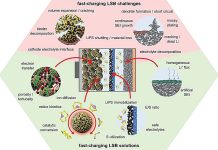
A team of dedicated scientists from Australia and around the world have found an innovative method to extract a crucial element, uranium, straight from the depths of our oceans.
The incredible research, a team effort led by Dr. Jessica Veliscek Carolan, was recently published in the journal Energy Advances and has stirred excitement in the scientific and energy communities.
Uranium, a mineral which you might have heard of in the context of nuclear energy, plays a pivotal role in powering nuclear reactors across the globe. It’s like the “fuel” that keeps the reactors running and producing electricity.
And here’s a fun fact – our vast oceans contain over a thousand times more uranium than what is available in the earth’s crust.
However, there’s a catch – the uranium in the sea is diluted, meaning it’s mixed thoroughly with seawater and is tricky to separate out, especially with all the other elements like salt, iron, and calcium being present in larger amounts.
So, the scientists, including Mohammed Zubair and honors student Hayden Ou from the University of New South Wales (UNSW), rolled up their sleeves and delved deep into a fascinating area of study involving a special type of materials called “layered double hydroxides” or LDHs for short.
LDHs have been in the scientific spotlight for a while due to their ability to latch onto and remove metals.
What makes them particularly exciting is that they’re quite straightforward to produce and can be tweaked to enhance their functionality.
Think of LDHs as little sponges that can be custom-designed to absorb specific substances, in this case, uranium.
The scientists experimented with adding different elements, called lanthanide dopants (like neodymium, europium, and terbium), to these LDHs to see if they could enhance their uranium-capturing capabilities.
And voila! When they added neodymium, the LDHs became particularly adept at choosing uranium over ten other abundant elements found in seawater.
Dr. Daniel Oldfield at ANSTO and Yuwei Yang at UNSW, using advanced microscopic techniques, took a closer look at these materials, unveiling the secrets of how they interact with uranium.
Meanwhile, the researchers utilized the powerful Australian Synchrotron, a type of giant microscope that uses X-rays, to understand more about how neodymium changes the uranium binding process.
What they found was that under seawater conditions, uranium atoms formed complex structures on the surface of the modified LDHs.
The magic seems to be in how neodymium changes the chemical bonding environment in the LDHs. It made the bond between metal atoms and oxygen more ionic, meaning they attract each other more strongly.
This stronger ionic bonding turned out to be the key to making these materials better at selectively holding onto uranium.
But the innovation doesn’t stop there! Not only do these neodymium-doped materials have the potential to extract uranium from the ocean for our energy needs, but they also could be utilized to clean up uranium from radioactive wastewater near nuclear power plants.
An exciting double whammy of providing a potential new source of uranium and also helping to manage environmental concerns related to nuclear power.
Dr. Veliscek Carolan highlighted the notable benefits of these materials: not only are they adept at pulling uranium from both seawater and radioactive wastewater, but they’re also simple and cheap to produce.
This could pave the way for an economical method for large-scale uranium extraction in the future, addressing both energy production and environmental cleanup in one go!
In an era where sustainable and clean energy sources are paramount, this research not only opens doors to potentially vast uranium reserves in the ocean but also introduces a methodology that is both economically and environmentally promising.
Imagine powering our future cities and technologies by tapping into the hidden energy resource beneath the ocean waves! With continued research and development, this could well be a wave of the future.
Follow us on Twitter for more articles about this topic.



